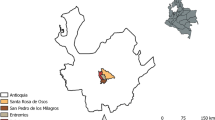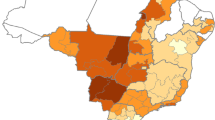Abstract
A cross-sectional study was conducted in Uganda between November 2006 and February 2007 to assess the seroprevalence and risk of brucellosis in zerograzing and pastoral dairy systems; two major sources of milk in Uganda, 80% of which is sold unpasteurized to consumers through informal channels. A total of 723 cattle comprised of 497 animals from the pastoral system and 226 animals from the zerograzing system were tested for antibodies against natural B. abortus infection using the competitive enzyme-linked immunosorbent assay (C-ELISA). Herd-level seroprevalence was 100% in the pastoral system and 5.5% (95% CI: 1.8, 9.2) in the zerograzing system. The animal-level seroprevalence and within-herd range of brucellosis in cattle in the pastoral system were 34.0% (95% CI: 29.9, 38.1) and 8.1–75.9%, while for those in the zerograzing system were 3.3% (95% CI: 0.9, 5.7) and 0–9.0%. Abortion rates of 23% and 0% among seropositive cows vis-à-vis 5.4% and 1.9% among seronegative cows were recorded in the pastoral and zerograzing systems, respectively. The risk of natural B. abortus infection was higher among older cattle (>24 m) (Odds ratio [OR] = 1.83, 95% CI: 1.25–2.67) and dry cows (OR = 2.01, 95% CI: 1.23–3.31) in the pastoral system, and in calves aged 0–6 m (OR = 5.72, 95% CI: 1.04–31.41) in the zerograzing system. Implementing a culling program in the zerograzing system to eliminate the existing low risk of brucellosis and targeting calves in the pastoral systems for vaccination could avert the cost-related limitation of brucellosis control in Uganda.

Similar content being viewed by others
References
Arimi, S.M., Koroti, E., Kang’ethe, E.K., Omore, A.O., McDermott, J.J., 2005. Risk of infection with Brucella abortus and Escherichia coli O157:H7 associated with marketing of unpasteurized milk in Kenya, Acta Tropica, 96, 1–8. doi:10.1016/j.actatropica.2005.05.012
Berhe, G., Belihu, K., Asfaw, Y., 2007. Seroepidemiological investigation of bovine brucellosis in the extensive cattle production system of Tigray region of Ethiopia, International Journal of Applied Research in Veterinary Medicine, 5, 65–71.
DDA, 2004. Annual report of the Dairy Development Authority in Uganda for 2003–2004, http://www.dda.or.u/.
Epiphanies, E., 2007. Zoonotic disease survey in Karamoja, Uganda, http://epivet.blogspot.com/.
Faye, B., Castel, V., Lesnoff, M., Rutabinda, D., Dhalwa, J., 2005. Tuberculosis and brucellosis prevalence survey on dairy cattle in Mbarara milk basin (Uganda), Preventive Veterinary Medicine, 67(4), 267–281. doi:10.1016/j.prevetmed.2004.11.002
Greiner, M. and Gardner, I. A., 2000. Application of diagnostic tests in veterinary epidemiologic studies, Preventive Veterinary Medicine, 45, 43–59. doi:10.1016/S0167-5877(00)00116-1
Grimaud, P., Byarugaba F., Ssekawojwa, E., Etter, E., Nasinyama, G., 2007. Risk assessment of major zoonotic diseases in Uganda (Abstract). In: Camus, E., Cardinale, E., Dalibard, C. Martinez, D., Renard, J-F. and Roger, F. (Eds), Does control of animal infectious risks offer a new international perspective?: Proceedings of the 12th International Conference of the Association of Institutions of Tropical Veterinary Medicine. Montpellier: CIRAD, p.122, http://publications.cirad.fr/.
Henry, J.B., 1989. Brucella. Clinical Diagnosis and Management. 17th Edition, W.B. Saunders, Philadelphia, USA.
Jiwa, S.F.H., Kazwala, R.R., Tungaraza, R., Kimera, S.I., Kalaye, W.J., 1996. Bovine brucellosis serum agglutination test prevalence and breed disposition according to prevalent management systems in the Lake Victoria zone of Tanzania, Preventive Veterinary Medicine, 26, 341–346. doi:10.1016/0167-5877(95)00543-9
Kabagambe, E.K., ELzer, P.H., Geaghan, J.P., Opuda-Asibo, J., Scholl, D.T., Miller, J.E., 2001. Risk factors for Brucella seropositivity in goat herds in eastern and western Uganda, Preventive Veterinary Medicine, 52, 91–108. doi:10.1016/S0167-5877(01)00251-3
Kadohira, M., McDermott, J.J., Shoukri, M.M., Kyule, M.N., 1997. Variations in the prevalence of antibody to Brucella infection in cattle by farm, area and district in Kenya, Epidemiology and Infection, 118, 35–41. doi:10.1017/S0950268896007005
Kunda, J., Fitzpatrick, J., Kazwala, R., French, N.P., Shirima, G., MacMillan, A., Kambarage, D., Bronsvoort, M., Cleaveland, S., 2007. Health-seeking behaviour of human brucellosis cases in rural Tanzania. BMC Public Health. 7:315. doi:10.118611471-2458-7-3-315, http://www.biomedcentral.com/1471-2458/7/315.
Kyebambe, P.S., 2005. Acute brucella meningomyeloencephalo-spondylosis in a teenage male, African Journal of Health Sciences, 5, 69–72.
Mangen, M.-J., Otte, J., Pfeiffer, D., Chilonda, P., 2002. Bovine brucellosis in sub-Saharan Africa: Estimation of seroprevalence and impact on meat and milk offtake potential. FAO Livestock Policy Discussion Paper No. 8. Food and Agriculture Organisation of the United Nations, Rome.
McDermott, J.J., Arimi, S.M., 2002. Brucellosis in sub-Saharan African: epidemiology, control and impact, Veterinary Microbiology, 90, 1–4. doi:10.1016/S0378-1135(02)00249-3
Nakavuma, J., 1994. Serological survey of Brucella abortus in cattle and goats in central and southern regions of Uganda. M.Sc. thesis, Makerere University, Kampala.
Nielsen, K., 2002. Diagnosis of brucellosis by serology, Veterinary Microbiology, 90, 447–459. doi:10.1016/S0378-1135(02)00229-8
Oloffs, A., Baumann, M.P.O., Afema, J., Nakavuma, J., 1998. Experiences with a strategy to investigate bovine brucellosis in a rural area in Southwest Uganda, Revue d’élevage et de Médeicine Véterinaire des Pays tropicaux, 51(2), 101–105.
Acknowledgement
We thank Geoffrey Odyek, Joseph Muboli and Jackson Mawejje for their technical assistance. We are grateful to district veterinary personnel for their cooperation during sampling. We thank Dr J.T. Odimim for facilitating access to zerograzing units initiated by the Farming in Tsetse Controlled Areas (FITCA) project. This study received financial support from the Agricultural Research and Training Program (ARTP) II of the National Agricultural Research Organisation (NARO). This paper is published with permission of the Director, National Livestock Resources Research Institute (NaLIRRI).
Author information
Authors and Affiliations
Corresponding author
Rights and permissions
About this article
Cite this article
Magona, J.W., Walubengo, J., Galiwango, T. et al. Seroprevalence and potential risk of bovine brucellosis in zerograzing and pastoral dairy systems in Uganda. Trop Anim Health Prod 41, 1765–1771 (2009). https://doi.org/10.1007/s11250-009-9375-y
Received:
Accepted:
Published:
Issue Date:
DOI: https://doi.org/10.1007/s11250-009-9375-y




